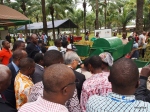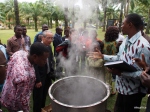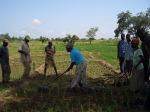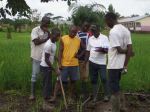Educational video for SMART-Valleys approach now avaialble (FR/EN)
As part of the full instruction package on the Smart-valleys approach an educational video has been produced. The video helps farmers to get a better understanding of the proposed methodology, start discussions on the feasibility in their community, and on how to implement it in their inland valleys. The video is currently available in English and French, but translations will be made in at least 4 local languages in Benin and Togo including Ewe and Fon. In a later stage local versions will be prepared for usage in Liberia and Sierra Leone.
The video is the result of collaboration between AfricaRice, Cellule Bas-Fonds and MOOV-ON productions.
French
English
Do not hesitate to request copies of the videos on DVD (s.zwart@cgiar.org). The full training package of an instructors guide, a field guide and the the educational video will be available mid-2015.
Innovative adoption and diffusion research
The number of inland valleys developed using the Smart-valleys participatory approach is rapidly expanding. Around the demonstration sites and in the zones targeted by the SMART-VALLEYS project adoption is witnessed at significant scale. Lead-farmers and trained field technicians provided supervision and technical support to farmers in order inland valleys that have demanded their support. Trained farmers in the demonstration sites frequently leave those sites to be able to developed a larger area elsewhere using the approach.
AfricaRice wishes to understand at which scale adoption takes place and what are the most common and efficient diffusion pathways. Drs Arouna and Zwart, respectively Agricultural Economist and Remote Sensing and GIS specialist, have set up an innovative research to track adoption and map the diffusion pathways. Traditional adoption and diffusion surveys are being implemented backed by a remote sensing analysis of change detection and objected-oriented classification approaches. First results are expected early 2015. The presentation below provides an outline of the approach.
TV5 Afrique broadcasts the Rice Innovations Fair
The francophone channel TV5 Afrique broadcasted a 13 minutes item on the Rice Innovations Fair at AfricaRice in the TV-program WARI TV. The show was later repeated on TV5 Europe and several national and regional channels. The program presented an impression of the Rice Innovations Fair and the Smart-valleys development activities in Ouinhi.
The broadcast can be viewed here:
The agricultural development sector gathered in Cotonou for the Rice Innovations Fair
On September 1 and 2, the Africa Rice Center organized the first Rice Innovations Fair. Scalable rice technologies developed by AfricaRice and its national partners were presented and demonstrated to a wide audience from the agricultural development sector in Benin and Togo. These includes delegates from various national and regional NGO’s, research organizations, ministries and donors. AfricaRice researchers presented technologies that have been developed, tested and evaluated in the field and that are ready for scaling out. These technologies included:
- Smart-valleys – a participatory and low-cost development approach
- Inland valley atlas – assessing the potential for development
- RiceAdvice – localized farmer advice for nutrient management
- Multi-stakeholder platforms – improving farmers’ access to the value chain
- Powertillers – local adaptation to support multiple use
- ARICA – new lines of rice varieties
- Mechanic weeders – reducing labour in rice production
- USD Parboiler – energy efficient and improved quality
- ASI Thresher – high-capacity thresher for clean rice
- PLAR – Participatory Learning & Action Research for improving farmer practice
This was followed by demonstrations of the ASI thresher, the USD parboiler and an adapted powertiller for multifunctional use. New contacts were established with the aim to improve the efficiency of agricultural development projects by incorporating new technologies.
The second day a visit was paid to the Cummune of Ouinhi where several inland valleys have been developed using the Smart-valleys approach. The visitors were warmly welcomed by the mayor of Ouinhi who once again stipulated the importance of the collaboration with AfricaRice and Cellule Bas-Fonds to improve the rice production in his commune. A participatory evaluation of mechanic weeders was performed. The day ended with a meal of locally produced rice.
The 2013 agricultural season was a tough year for farmers in large parts of Benin and Togo. The delay of rains and the following drought conditions resulted in loss of crops and reduced yields. Farmers participating in the SMART project, however, reported less effects of the drought and in many sites we could witness substantial yields. Farmers noticed that the water retention through levelling and bunding of rice fields assured that the rice plants were able to overcome the drought period.
In Ouinhi several sites have been developed using the Smart-valleys approach and also the mayor of the commune has noticed his area is becoming a more and more important rice production area. On January 9 the SMART-IV project organized a rice harvest celebration day and on this occasion also the first powertillers were handed over to farmer groups that have been successful in the development of their inland valleys.
For this event the Ambassador of Japan in Benin was invited to join the celebration and share a rice meal with the rice farmers. Other guests included the Deputy Director General of AfricaRice, Dr Marco Wopereis, the Director General of CARDER Zou-Collines, the Director of the Genie-Rural, the Mayor of Ouinhi and the Director of the Cabinet of the Ministry of Agriculture.
 Dr Worou explaining the Smart-valley development approach
Dr Worou explaining the Smart-valley development approach
Zoungo is a large development site where more than 11 ha were developed in 2012 using the Smart-valleys approach. This year the rice farmers expanded their site themselves using the approach that they adopted the year before. The site is located on both sides of the busy road going north from Benin’s capital Porto-Novo. For its good visibility a road sign was placed earlier this year that explains the 5 steps of the Smart-valleys approach. Dr Worou Soklou, the regional development coordinator for the SMART-IV project, explained the methodology to the participants and outlined its advantages over other development approaches.
The participants then moved to the development site of Ahicon located just south of Ouinhi. This site is partially equipped with irrigation infrastructure that diverts water from a natural spring. Rice planting started late and the farmers were in the midst of the harvesting activities. Several farmers clarified on their own benefits from the approach. Before yields were low and they have significantly increased. They will now also able to cultivate rice during the dry season thus greatly increasing their food security and income.
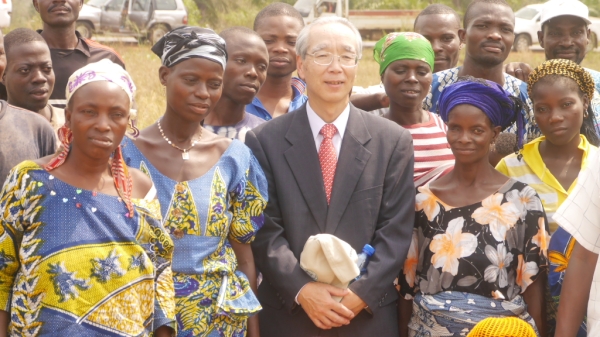 the Ambassdor of Japan amidst the rice farmers of Ahicon
the Ambassdor of Japan amidst the rice farmers of Ahicon
The final stop of the day was the ‘Centre des Jeunes et des Loisirs’ in the centre of Ouinhi. The rice farmers of Ouinhi and the participants gathered for speeches, the official hand over of the powertillers and the shared lunch. A warm welcome was provided the mayor of Ouinhi who claimed that Ouinhi is going to the major rice producing municipality in entire Benin. He also thanked the contributions of AfricaRice and Cellule Bas-Fonds and expressed that he is hoping on continued support to achieve his goals.
The DDG of AfricaRice explained that the Smart-valleys approach is an alternative to traditional interventions, which are usually expensive and time-consuming. Contrary, Smart-valleys is low-costs and participatory thus creating ownership with the farmers and making it easy to replicate. An example is Zoungo where farmers have already expanded their site. He finally thanked the people of Japan for their long-term support for this project as well as other projects at AfricaRice.
The Ambassador of Japan in Benin congratulated all involved in the SMART-IV project, the Ministry of Agriculture, Forestry and Fisheries, the AfricaRice researchers and notable the rice farmers with the achievements witnessed during this day. Food security and the development of the agricultural sector and making it more dynamic is one of the priorities of the Japan development cooperation. “For this reason AfricaRice will always remain of the development partners”, explained the Ambassador.
Finally, the Director of Cabinet of the Ministry of Agriculture handed over the keys of the powertillers to the leader of the farmers of Ouinhi. The powertillers will be introduced to farmer groups that have shown genuine interest in the development of their inland valley. The powertiller will support them to expand the rice cultivation areas and facilitate transport of inputs and the yields. The leader of the farmer expressed his gratitude, but also stressed the necessity for continued support to further develop the rice sector. In many sites the introduction of partial water management has had great impact, but the area is rich in natural water sources that can be exploited to achieve full water management which will allow them to cultivate rice twice or thrice a year.
The day ended with a shared meal prepared by the women of Ouinhi, of course with rice produced on the development sites of the project!
Trailer of educational video for the Smart-valleys approach
In the context of the project an educational video is being developed that will guide farmers and field technicians in the development of inland valleys using the participatory development approach developed by AfricaRice. The approach has now been baptized as ‘Smart-valleys‘, a participatory, low-cost and easy to replicate approach for developing inland valleys for rice based-systems.
The full video is being finalized, but the trailer is now available!
New road sign launched in Zoungo, Benin
On Monday December 2 a brand new road sign was placed ion the SSD site of Zoungo. The sign explains with pictures ans short text blocks the 5 different steps of SMART – a partipatory and low-cost development aproach. The site of Zoungo is located approximately 1,5 hour north of Porto Novo, the capital of Benin, on the much frequented road by traffic going north to the country. It is therefor expected to generate high visitbility.
SMART-IV presented at the Africa Rice Congress 2013 in Yaounde
From October 21 to 24, 2013 thee Africa Rice Congress was held in Yaounde, Cameroon. Dr Sander Zwarrt was invited to present the results of the SMART-IV project and in specific the particiaptory development approach that is being developed and tested. The presentation, which was attended by over 100 participants of the congress, can be watched below:
Dr Mutsa Masyiyandima presented a poster on the assessment of available water resources entitled: “Assessing water resources potential for increasing rice production in the Ouémé River basin, Benin”.
SMART-IV demonstration sites and trainings created impact in 2013!
Despite the lack of rains early in the season, farmers have continued there rice activities in most sites. Unfortunately, in some cases rice was abandoned or farmers continued at a smaller scale than foreseen. In both countries approaximately 40 ha is now cultivated in both the demonstration sites and the adoption sites. The figure below provides more details. In both countries, the project is active in three regions. And in each of the regions several demonstration sites have been set up. In Benin the sites are larger in area, but there are less in total, whereas the sites in Togo are often much smaller, but they are more numerous.
The demonstration sites are now creating impact, already in the second year of the project. In Benin one site is now under Sawah System Development and it was developed by farmers solely without outside technical support. In Togo several of such sites have been observed in the Kpalime region, but not all of them have yet been identified. In the trainings given in Togo there was participation from field technicians of the NGOs ETD and GRED. They have now developed several sites in the central and outhern regions with limited technical support from the SMART-IV project. These sites have been inventoried and were added to the map.
These results are preliminary and more details on farmer participation and areas will be provided in due course!
Farmers test and select mechanic weeders in Togo
A major constraint for rice farmers in Africa is the presence of weeds. Weeds can cause significantly yield losses (even up to 100%) and removal is costly. Certain farmers apply herbicides before the start of the cultivation, but very often weeding is done by hand and often it’s women performing this task. The SMART-IV project has moved into a second phase after the successful start of development activities. In the demonstration sites new tools and agricultural techniques will be tested in a participatory manner. If necessary tools will be adapted to local conditions and once found suitable they can be introduced at larger scale.
Dr Atsuko Tanaka recently conducted a participatory on-site evaluation of mechanic weeders in two demonstration sites (Kemelida and Gnatre) in central Togo. The same trials will later be conducted in sites around Ouinhi, Benin. A total of 6 different weeders were tested in different conditions and thereafter each of the farmers rated the suitability of each.
Due to the shortage of rainfall, most of the fields were dry at the time of mechanical weeder evaluation. In Gnatre, evaluation was conducted on dry field and field with ponding water. In Gnatre, 10 farmers and 11 farmers participated in mechanical weeder evaluation for dry soil condition and ponding water condition, respectively. Kemelida, only dry soil condition was found for trial in which 12 farmers participated. On dry soil, ring hoe (Fig. 5) was most preferred. Out of 22 farmers, 73% farmers (16) chose ring hoe as their most preferred weeder.
The reason why the farmers preferred ring hoe was because of no need to bend their back for weeding, no back pain and quickness in operation. The least favoured weeder on dry soil was cono weeder because soil being entangled with nails and slowness in operation. For wet soil, on the other hand, cono weeder was most preferred followed by ring hoe. The major reason for preferring cono weeder was high operation efficiency in water.
Further on-site participatory testing will be conducted this season so that for the next SSD season (2014) the ring hoe weeder can be introduced at larger scale.






